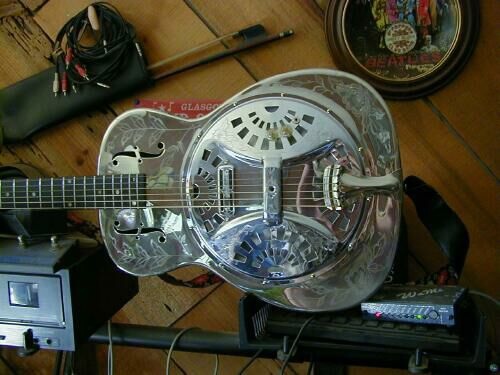I have one of these for each instrument:
http://thestringcleaner.com/ I use it when putting the instrument away, and just leave it on. Then I give it a quick zip up the strings before playing. My strings stay bright a lot longer now, and I can't imagine an easier way to maintain strings.
By the way, I always ask the bartender or waitress if I can have a clean bar-towel or two. They're fantastic for keeping your stuff clean and spanky. And they're free. Always an attractive quality.
The Dopera brothers (that's how they spelled their surname) were family friends, so I got to spend a lot of time in their Dobro factory when I was a kid.
Here's the Dobro Ed Dopera made as a gift to my dad:

Ed believed that ammonia from Uric acid was the cause of corrosion, so the earliest Dobros were made of a special corrosion resistant bell brass from Czechoslovakia, which was then plated with nickel and/or chrome. (Ed still had a stash from the 1930s he used for special instruments, like my dad's.)
Fingerboards were red bean wood or ebony. (Most postwar models had rosewood fingerboards.) as a finishing touch the fingerboards and armrest area of metal-bodied roundneck Dobros were given a thin coat of bowling alley wax (I kid you not).
If I can quit blabbering down memory lane here and get back to the topic (my wife, the Foghorn, says I should wear a sign that says: don't get me started), the crack in the fingerboard of the Series 1 guitar that this thread was ostensibly about was probably not caused by drying out, in my astoundingly humble opinion. (Though of course that could be a factor.)
Look at where it is: a small area in the middle of the fingerboard, only an inch or two long. Most fingerboard cracks I've seen were near the ends of the fingerboard, especially at the body end. The nut usually keeps everything together on the other end.
Since the only thing going on underneath that section of fingerboard is the trussrod channel (I don't know if dual truss rods were standard then) that seems a likely culprit. I'll bet somebody went; ooh, something bright and shiny! I'll just stick a socket on that sucker and crank it until I hear a cracking sound!